Although the weather forecast had said it would be partially cloudy, meaning with sunny periods, the following morning in Nuremberg was completely overcast and with no separately visible clouds, but rather the entire sky was covered by a uniformed grey colour. Provided, grey is a colour. However, this did not worry me too much, for it can often be a mist that slowly goes up and clears with time. And such was the case on this day, although there were not too many sunny intervals. At first, I did grumble silently for the lack of sun, but soon I remembered I had expected rain, wind and cold during my entire stay, so I reminded myself that it was important it was dry.
Position and distance between Nuremberg and Rothenburg
Rothenburg is some 2 hours away from Nuremberg by train. When doing this trip, one needs to change trains and change them twice. I was a little worried when the train leaving from Nuremberg was a little late with its departure, but eventually it all worked out and I arrived in Rothenburg on time. Originally, I had planned to spend 5 hours in Rothenburg, but in the end I went there one hour earlier and stayed there one hour longer than planned. In other words, I spent 7 hours visiting the town, including coffee breaks and numerous stops for taking photos. I managed to visit everything I wanted, but if I had had more time, that would not have been too much.
The full name of this town is Rothenburg over the Tauber (Rothenburg ob der Tauber). This is important, as there are several places with the same basic name, so it helps avoid a mix-up. I decided to visit this destination on the basis of a guide-book which recommended a visit to Rothenburg even more than the one to Nuremberg. And I was not disappointed.
Rothenburg is an old town and the records show that there were some castles here already in the 12th century. The castles probably served more for strategic purposes taking into account the high and very steep elevation above the meanders of the Tauber river where they were built. Be as it may, a lot was destroyed in a 14-century earthquake, but the town was rebuilt again. However, at some point Rothenburg became very poor and could no longer follow the masonry fashion, so it actually remained more or less the same as it was in the 16th century.
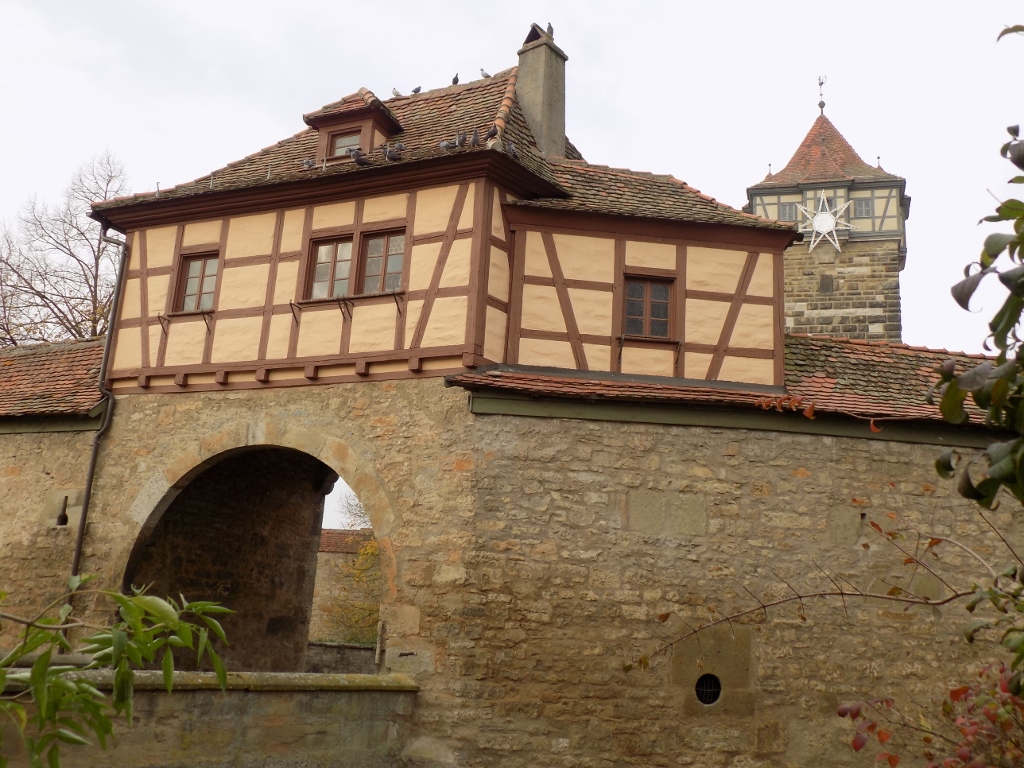 An entrance into the central part of Rothenburg
An entrance into the central part of Rothenburg
Having arrived at the train station, I headed for the old part of the town which is only some 10 minutes on foot away. Following the route I have envisaged, the town is entered at the observation tower Rödertor. Namely, the entire town is surrounded by ramparts with numerous towers and it is all perfectly preserved.
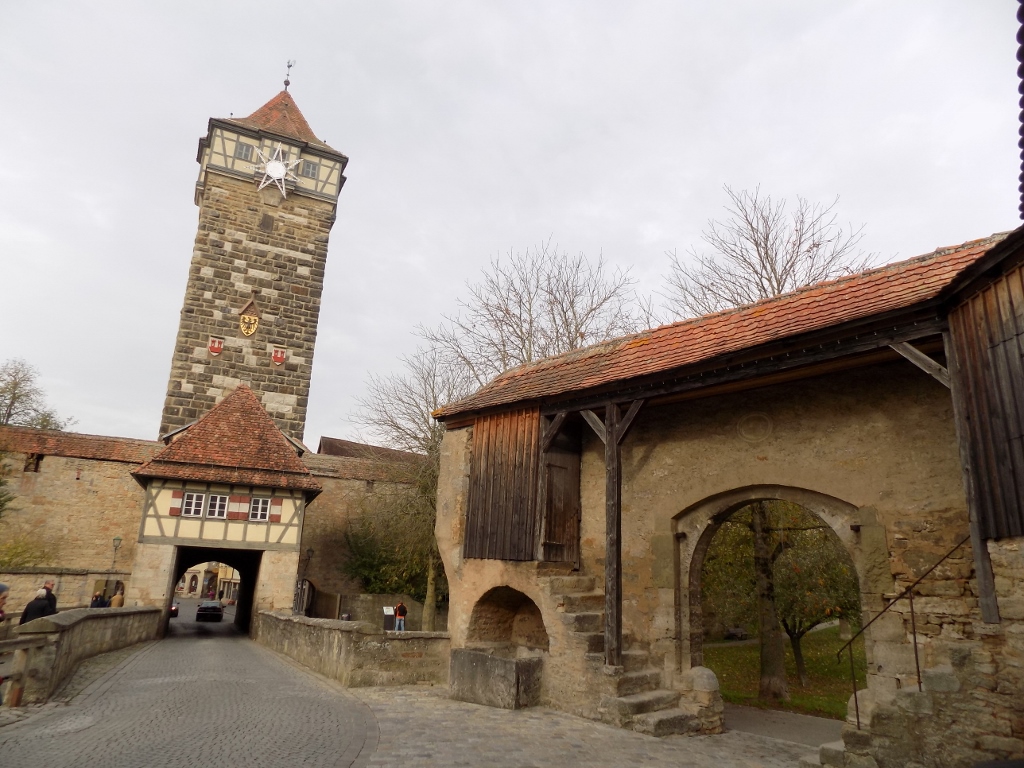 Entrance into the central part Rothenburg, Rödertor
Entrance into the central part Rothenburg, Rödertor
The ramparts were built during the 13th and the 14th centuries, and there are 5 big observation towers along them and a number of smaller ones. On the interior side of the ramparts, along their upper section there is a passage which can be used nowadays as well and one can easily imagine soldiers of the past passing by hurriedly when defending the town.
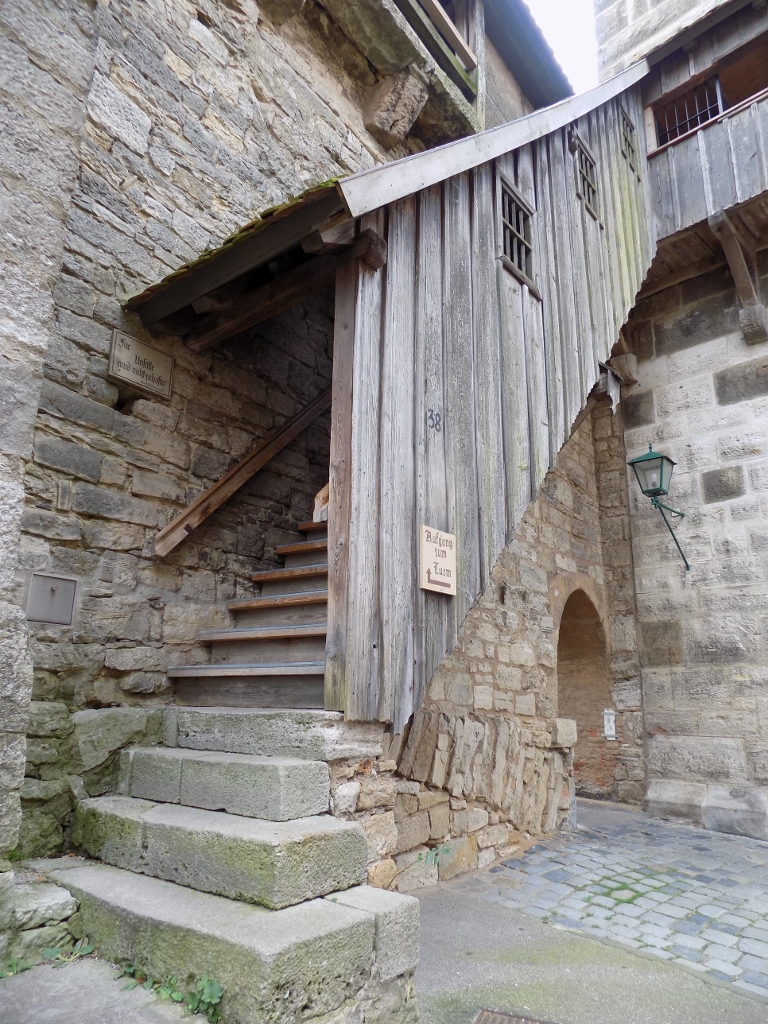 Stairs leading towards the “hallway” along the ramparts, at the Rödertor
Stairs leading towards the “hallway” along the ramparts, at the Rödertor
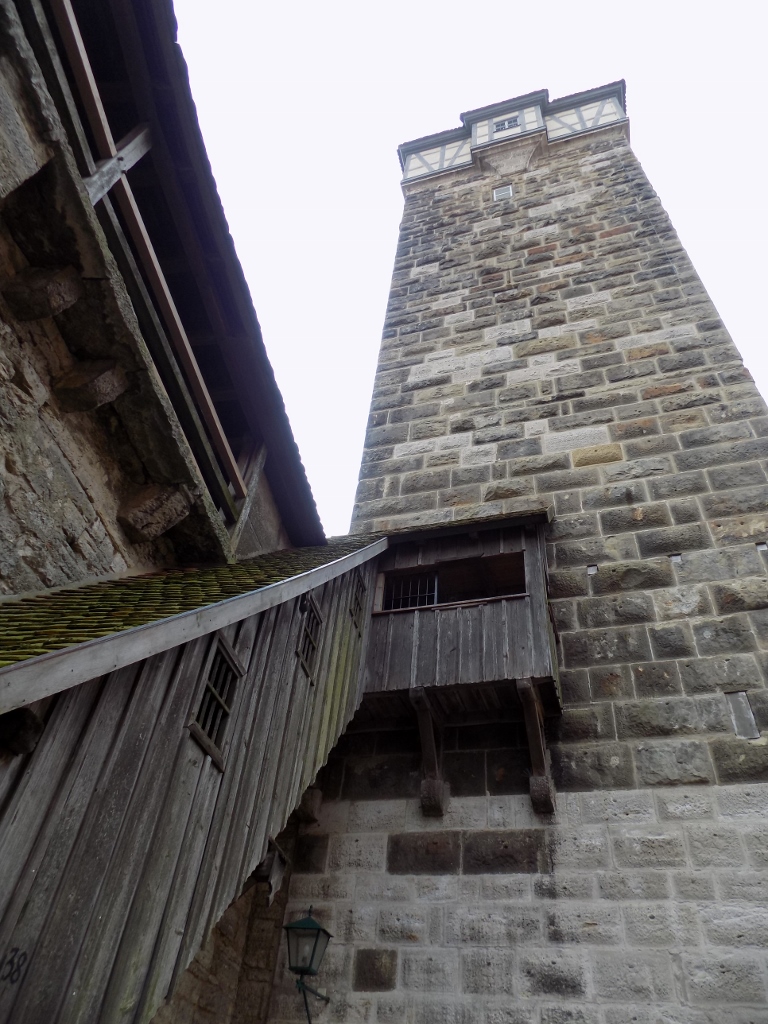 Stairs leading towards the “hallway” along the ramparts and the Rödertor
Stairs leading towards the “hallway” along the ramparts and the Rödertor
Of course, when you get into the old part of the town, in addition to vehicles passing by, there are also numerous shops, so there is no doubt you are in the 21st century. On the other hand, the buildings themselves, although very nicely maintained in compliance with the rules of the modern times, with their high gables and with occasional half-timber construction, unquestionably reflect the old age when they were originally built.
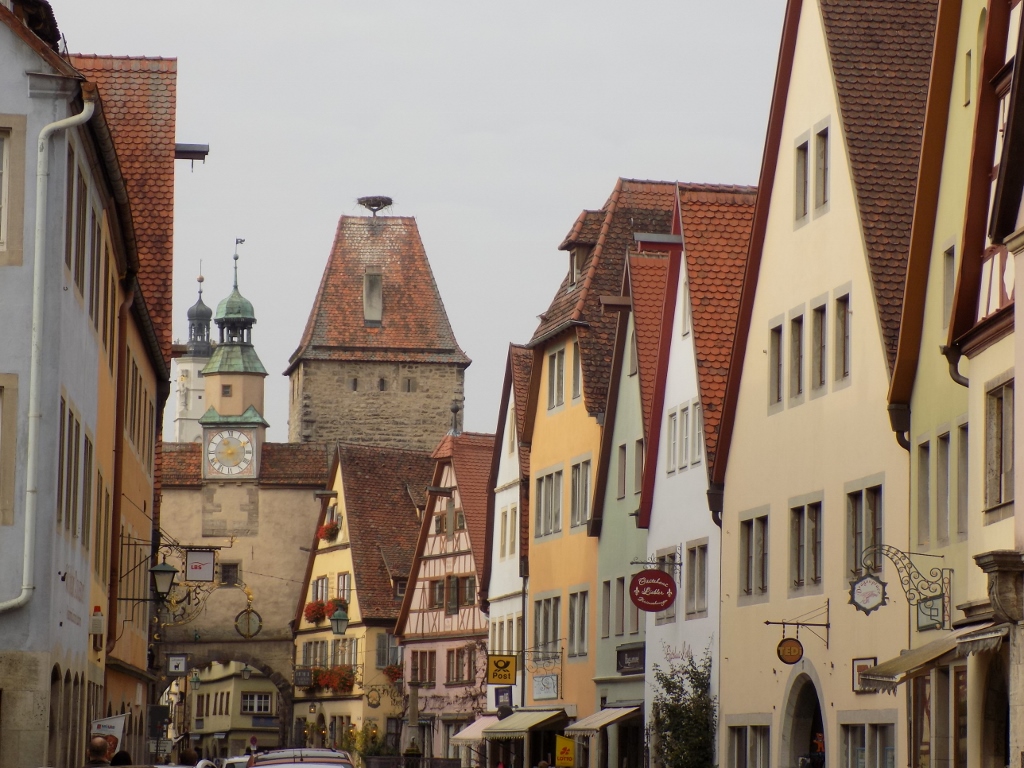 One of the main streets in Rothenburg, with the tower Markusturm in the background
One of the main streets in Rothenburg, with the tower Markusturm in the background
There is also a number of drinking-fountains from the old times that may be seen around the town. One of them I saw in the street Rödergasse through which I passed.
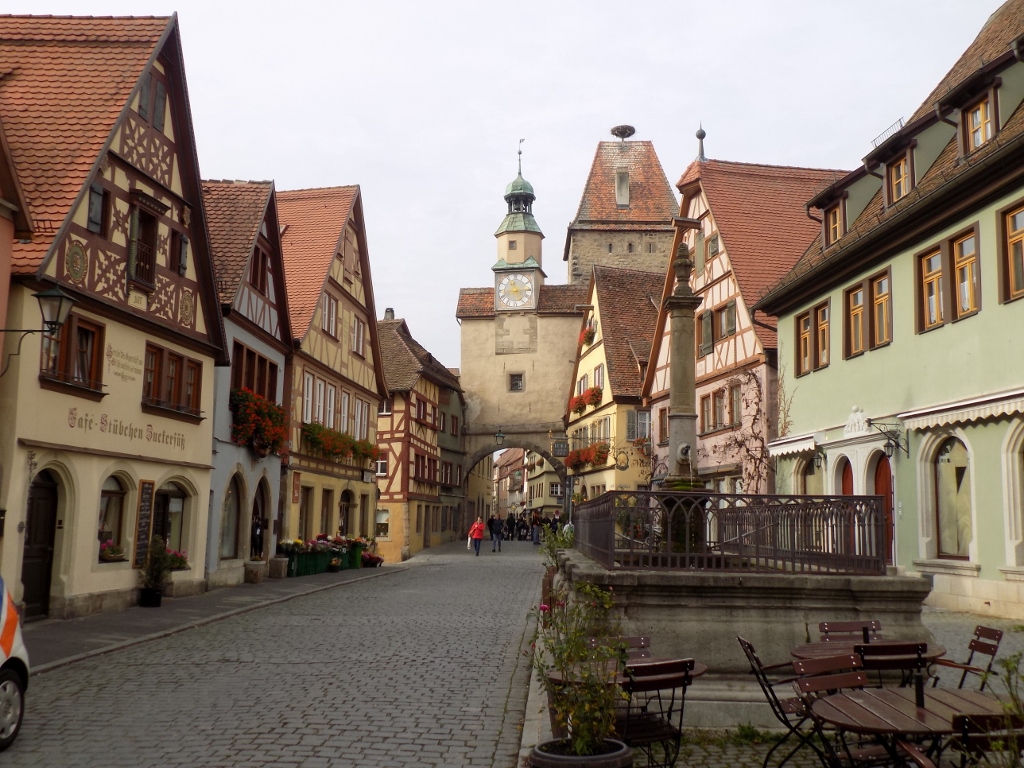 One of the main streets in Rothenburg with a drinking-fountain
One of the main streets in Rothenburg with a drinking-fountain
And, of course, there are a lot of flowers that almost regularly adorn the windows of German houses.
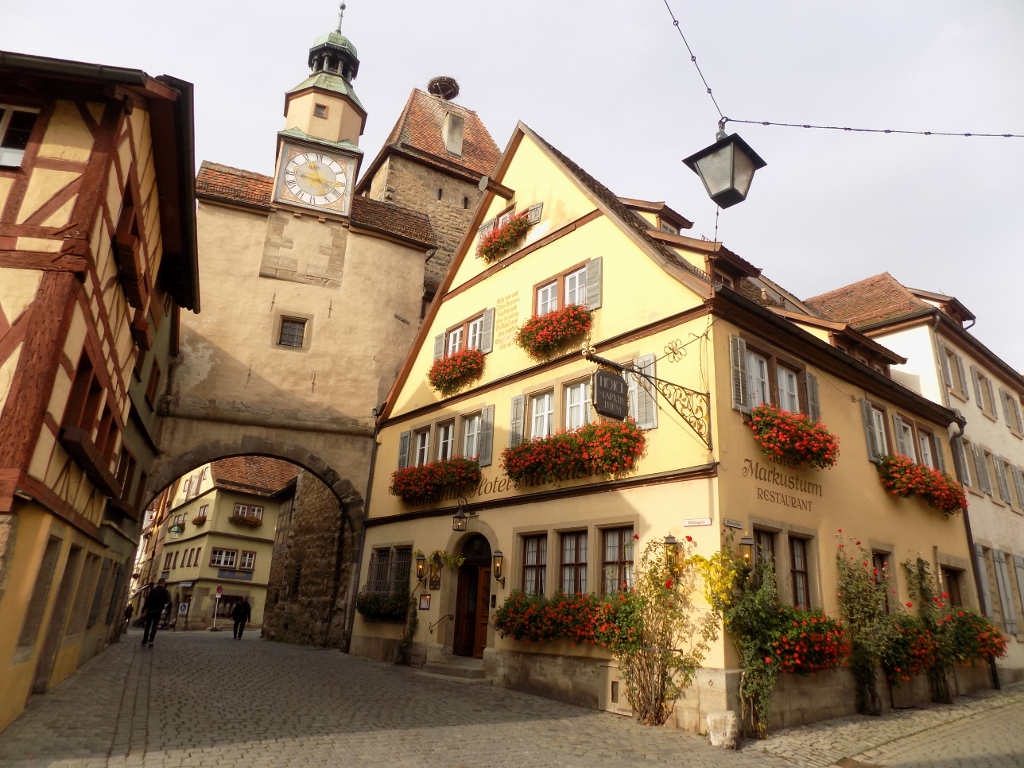 Near Markusturm
Near Markusturm
Since the previous day in Nuremberg I spent the entire afternoon running around in order to take photos while it was daylight and dry, and I knew I had enough time in Rothenburg, very soon after arriving in the old town I went for a coffee and some pastry. I had already had breakfast, but this was a nice addition and helped me feel I was on a mini-vacation. Still, this eventually came to an end and I continued with my sightseeing. Following the same street I headed towards the main square called Marktplatz, meaning Market Square.
In Marktplatz I came across numerous metal fences and some loud music, for it was all obviously set for a street race that was organized in Rothenburg, but I didn’t know when it was. It was not too crowded though, so I concluded it was still too early for the competition. Although the meek sun shed wonderful light on a café which had tables in the square, I still resisted the temptation because I had left another café just some minutes earlier.
At the square there is a large City Hall which actually consists of two parts. Let me put it this way – it consists of a brownish and of a whitish parts. The first one faces the square with its side wall, while the other, the whitish one, may be recognized by its 60 metre tall tower. They were also made in two different styles – the brownish one is the piece of Renaissance, while the whitish one was made in the Gothic style.
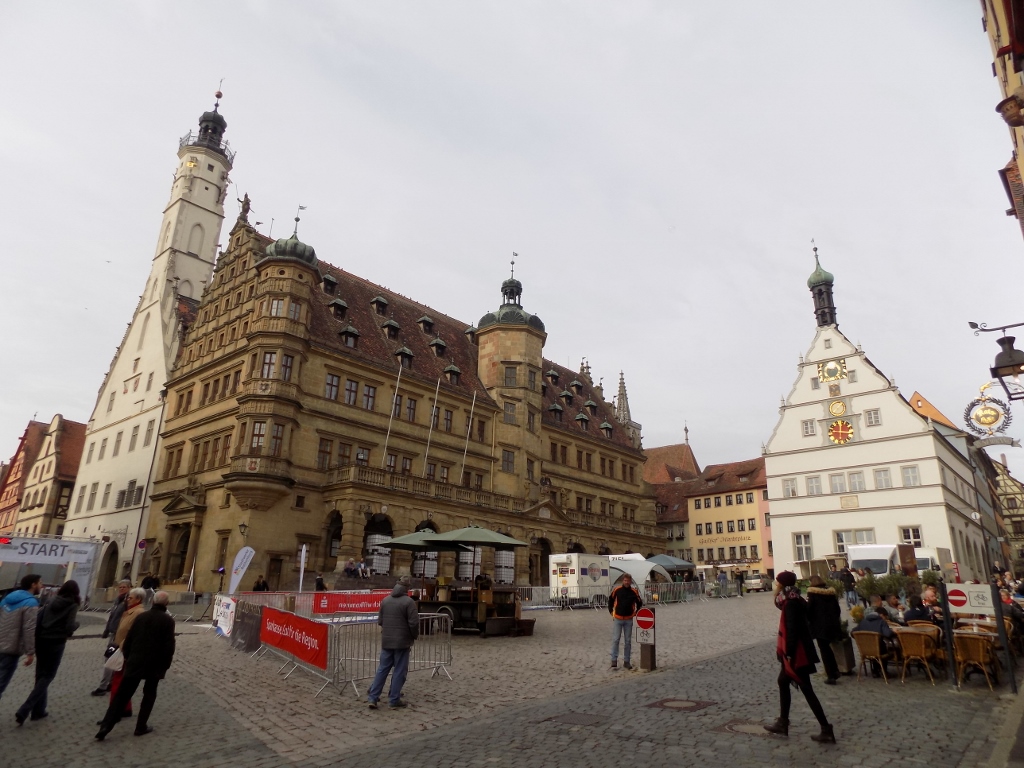 Marktplatz in Rothenburg: the City Hall is to the left and Ratstrinkstube is to the right
Marktplatz in Rothenburg: the City Hall is to the left and Ratstrinkstube is to the right
The square also contains another interesting building and that is Ratstrinkstube. Namely, there is a story that during the Thirty Years War that was waged in the first half of the 17th century, Rothenburg was conquered by a general who was very adamant in his decision to completely demolish the town. They begged him, pleaded with him, but no. He was a very decisive man. And yet... It occurred to someone to get him into a better mood by offering to him the best wine there was in the town. And there the general showed his softer side and gave up the demolition, but under a condition, just to show that he was a man of integrity after all, but in reality it all came down to the fact that he was extremely whimsical and he could have his way any way he liked. So, his condition was for the town to delegate one of its residents who would have to drink bottoms up a pitcher of that wine and the volume of this particular pitcher was almost 3 litres. So, one brave fellow stepped up to the plate and even his name is known, Nusch, he drank up all the wine and the town was saved. What happened to him afterwards is not known, but his feat and indeed himself have been immortalized precisely on the front side of the Ratstrinkstube building. Every day, several times a day and at exact times, the windows on the gable open and there one can see the figures of the whimsical general and of the good fellow with an overwhelming drinking capacity.
Of course, there are other picturesque buildings around the square and there is also an unavoidable fountain, but this one in the main square, St. Georgs Brunnen, was protected by a metal cage, at least its central part and I can only presume that this was in order for the pretty fountain to be protected against birds.
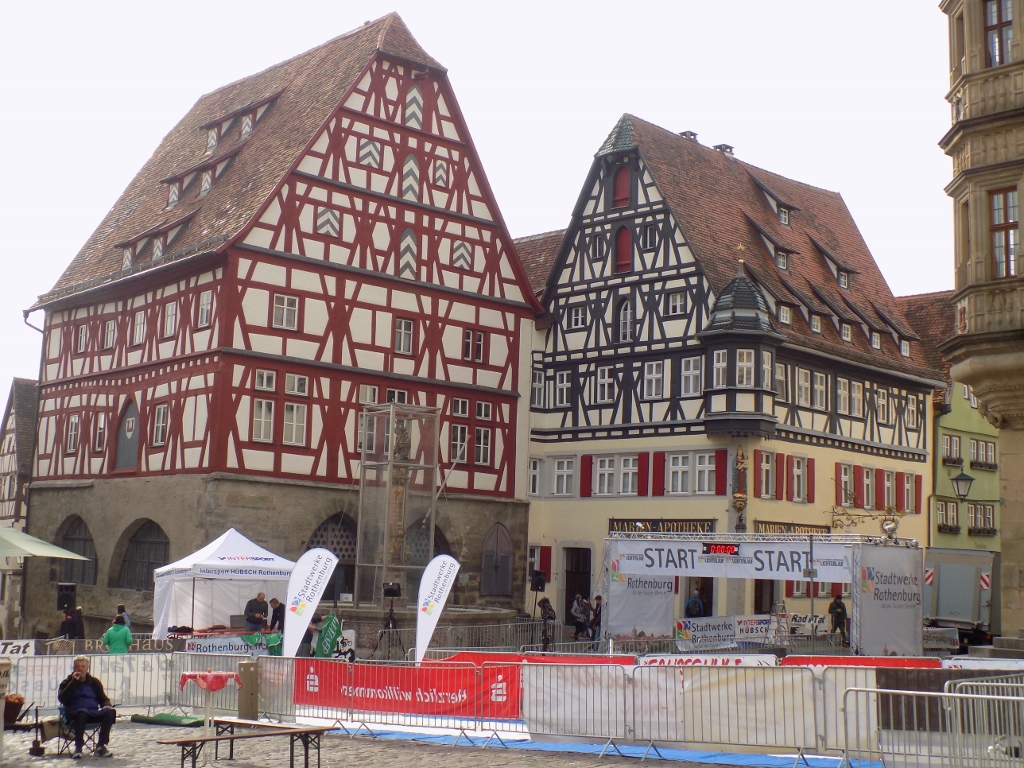 Marktplatz in Rothenburg – beautiful buildings and the fountain
Marktplatz in Rothenburg – beautiful buildings and the fountain
Next to the building on the right in the above photo, there is the German Christmas Museum (Deutsches Weihnachtsmuseum). I was here at the beginning of November, but everything was already getting prepared for the celebration of Christmas. Yet, I presume that in the middle of summer a visit to this museum may seem a little odd.
In addition to the picturesque buildings, ramparts and fountains, in Rothenburg there is also a large number of signs for cafés and shops made of cast iron and brass elements which occasionally dazzled in the sun as if they were made of gold.
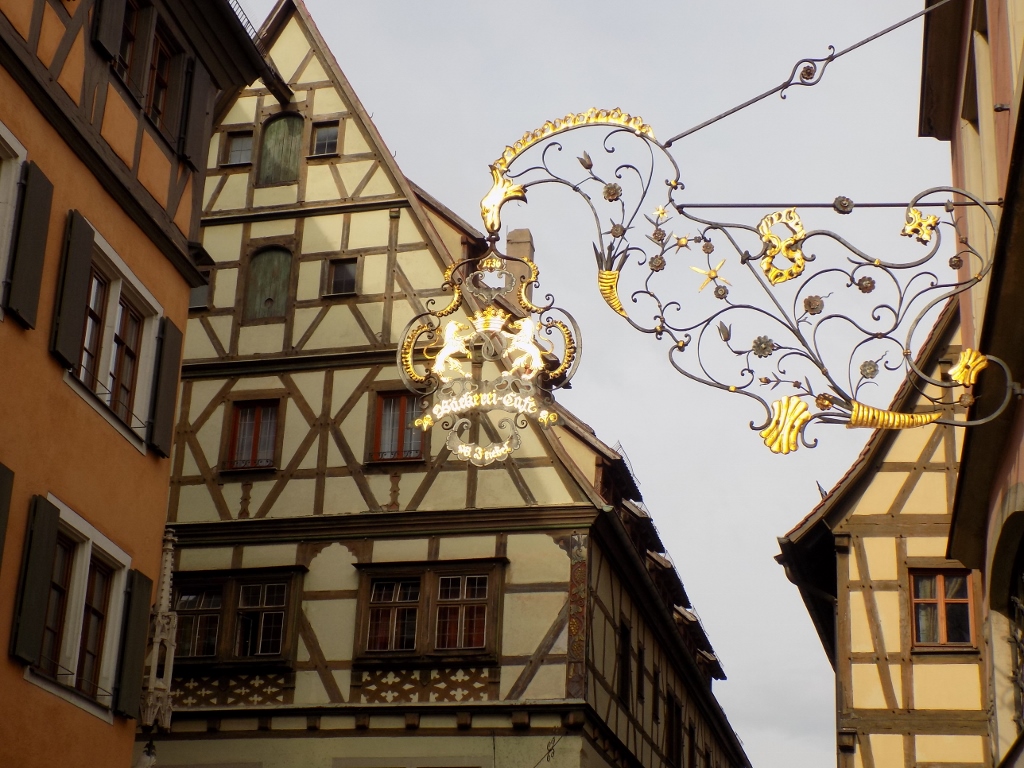 A detail from Rothenburg
A detail from Rothenburg
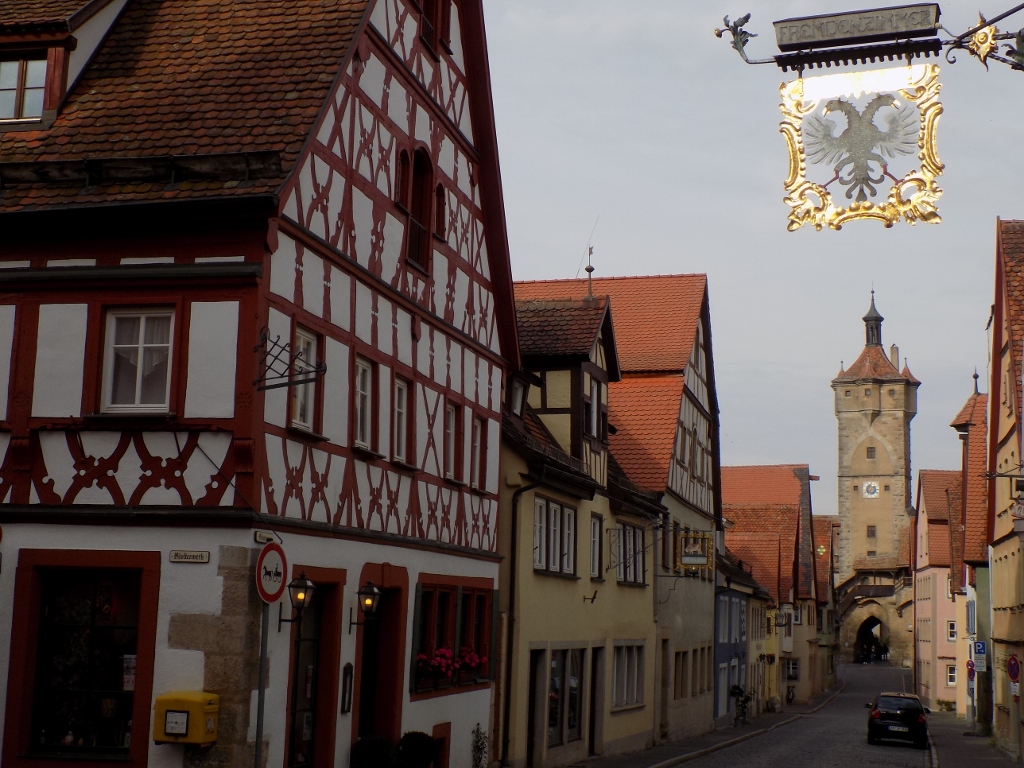 A detail from Rothenburg; at the end of the street there is the Klingentor observation tower
A detail from Rothenburg; at the end of the street there is the Klingentor observation tower
Needless to say, every now and then one comes across the numerous drinking-fountains. I don’t know if the water is still used nowadays and if so, what it is used for, but it was certainly running.
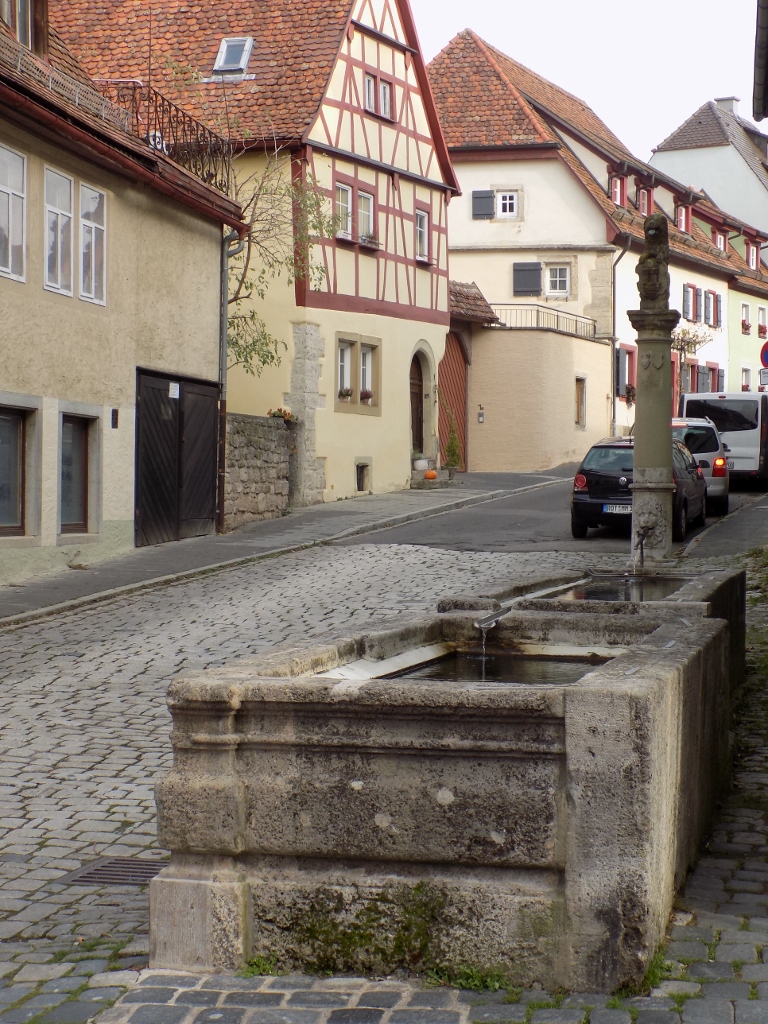 A detail from Rothenburg, one of the numerous drinking-fountains
A detail from Rothenburg, one of the numerous drinking-fountains
From the very centre I headed beside a 16th-century college and St. Jacob’s Church towards a big observation tower located in the north-west of the town. This is the Klingentor tower and close to it, on the external side of the ramparts, i.e., outside the fortified part of the town, there is a very unusual St. Wolfgang’s Church. The church is unusual because it does not have a regular ground plan, in addition to which under that part of it that deviates from the church’s axis, there is a tunnel used for both vehicles and pedestrians. When one enters the church, it may be clearly seen that this is an integral part of the building, although it may not seem quite so from the outside.
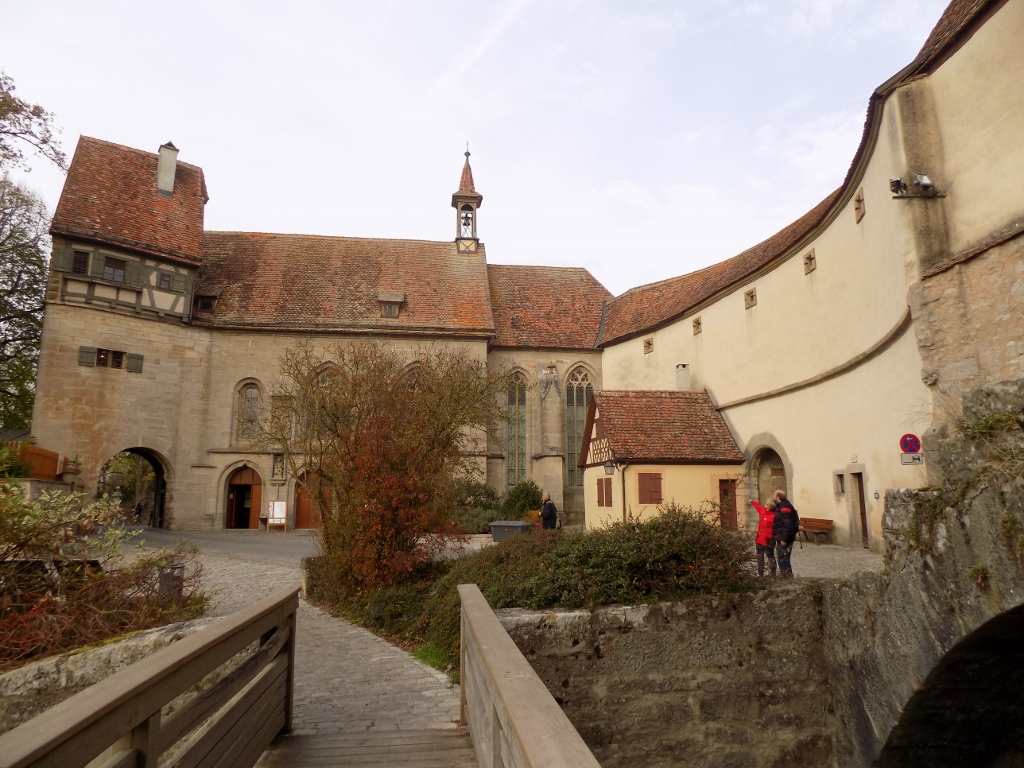 St. Wolfgang’s Church; pay attention to the left part of the building – a tunnel passing through a church
St. Wolfgang’s Church; pay attention to the left part of the building – a tunnel passing through a church
Like in the several points along the ramparts surrounding the town, at the observation tower Klingentor it is also possible to climb steep stairs in order to get to the passage that surrounds the town along with the walls.
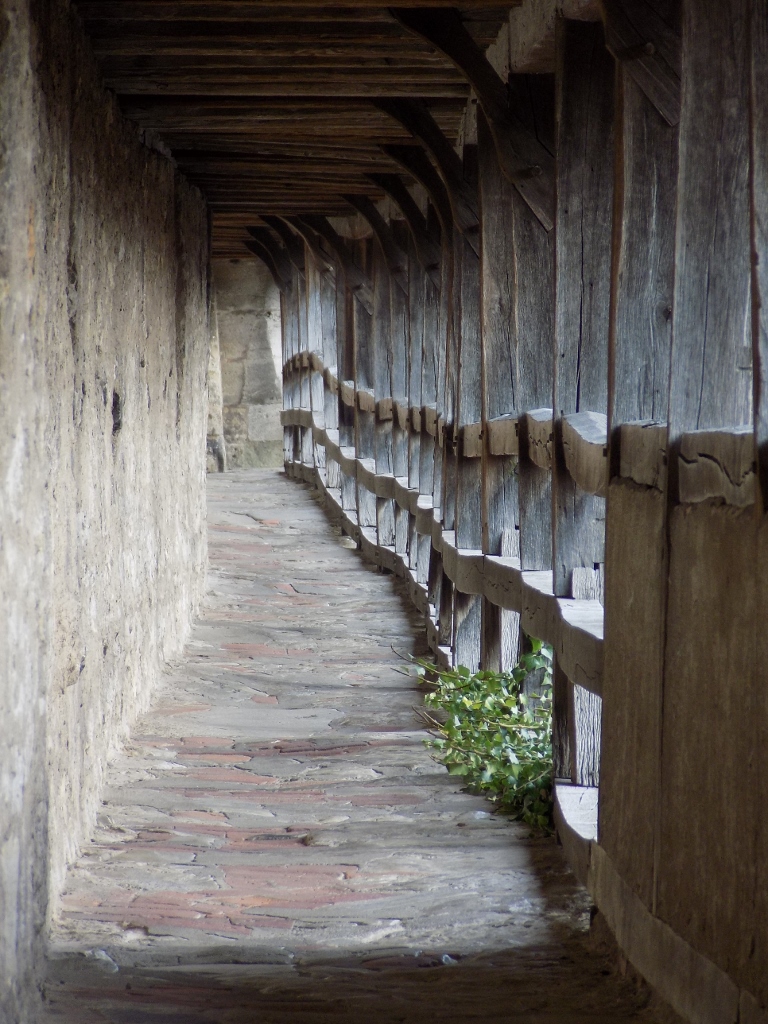 “Hallway” along the ramparts, Rothenburg
“Hallway” along the ramparts, Rothenburg
But, when one climbs to that passage, other than being able to walk along it, this is also an excellent opportunity to get another point of view at the town, from a certain height, and also to observe better some of the details.
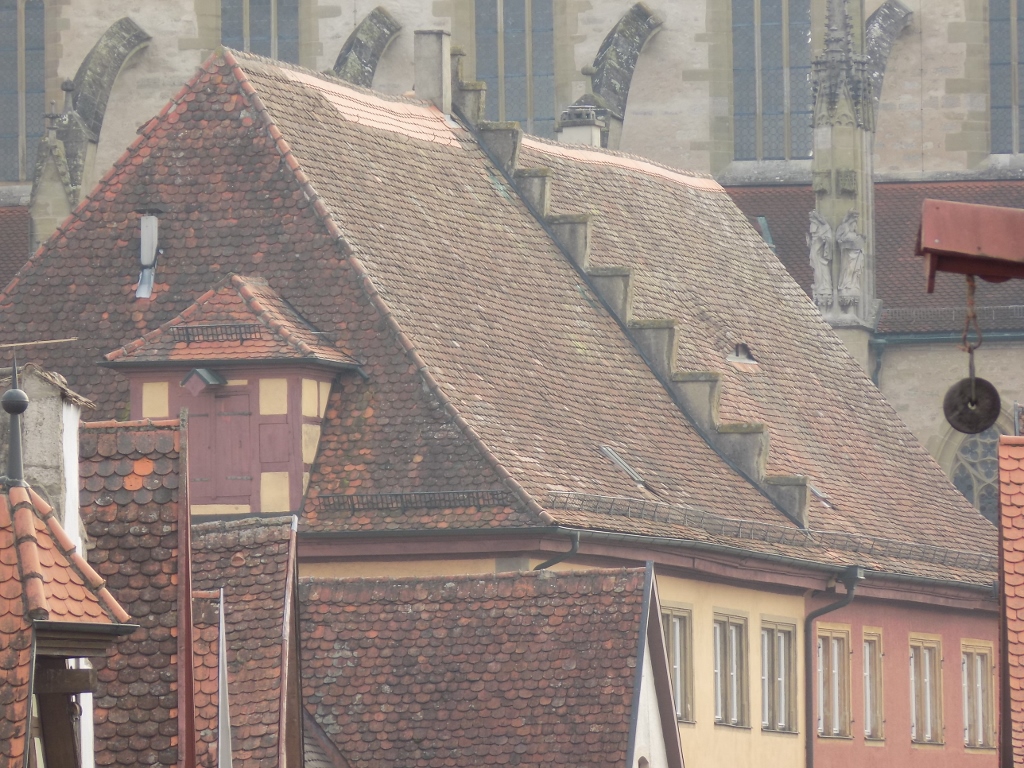 Rothenburg roofs – St. Jacob’s Church in the background with a hoist on the right hand side used for brining in and taking out things from the exterior side of the building
Rothenburg roofs – St. Jacob’s Church in the background with a hoist on the right hand side used for brining in and taking out things from the exterior side of the building
Still, from there I went down to the ground, following the ramparts southwards from the interior side. In that section there are several smaller towers, while on the outside there is a park.
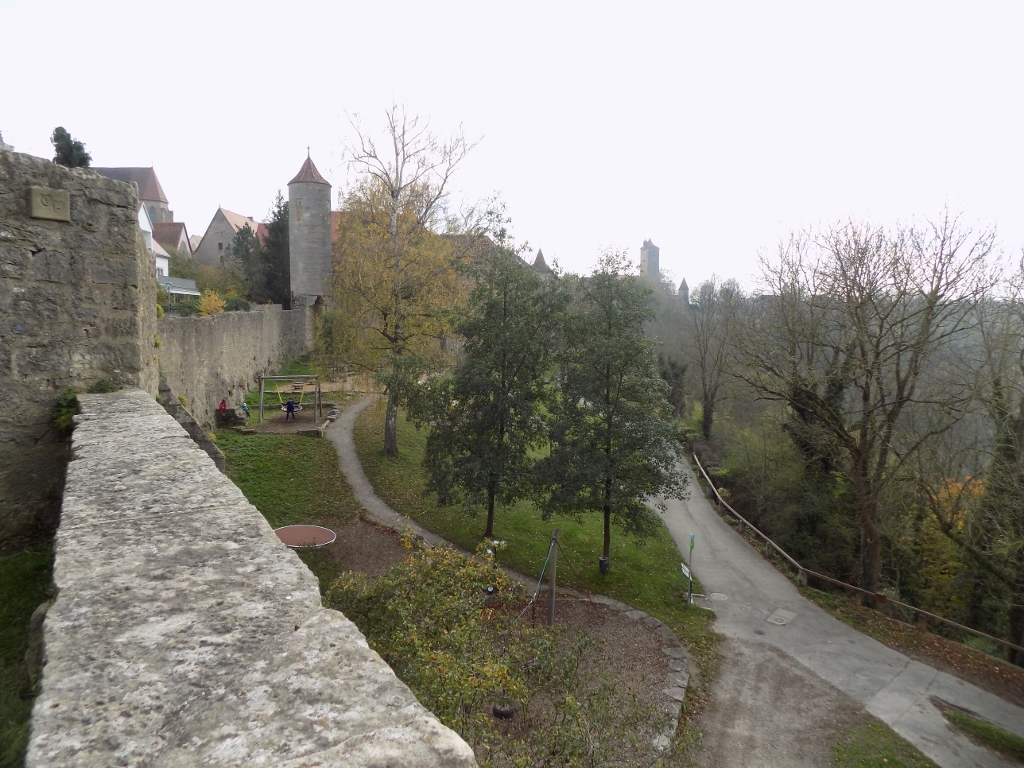 Walls around Rothenburg
Walls around Rothenburg
Occasionally, I also went into smaller side streets. Other than passing by residential houses and a museum, I also came across a few smaller hotels and restaurants. What set them apart was how much their owners tried to make them pretty with such simple and yet so attractive details.
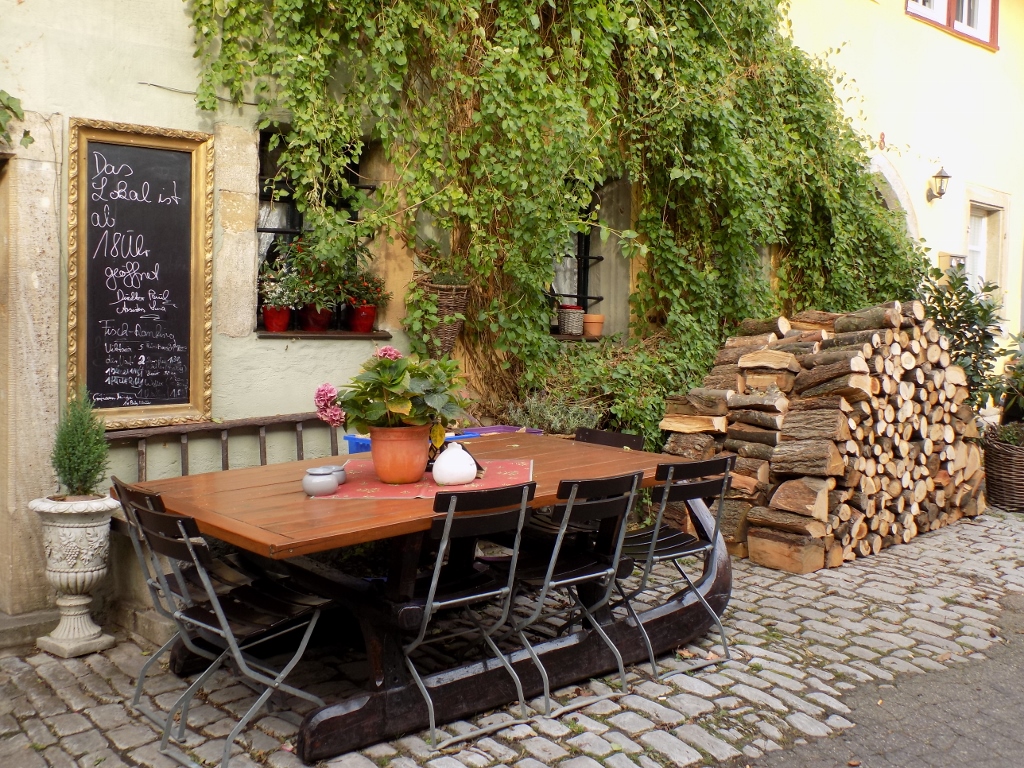 A detail from the streets of Rothenburg
A detail from the streets of Rothenburg
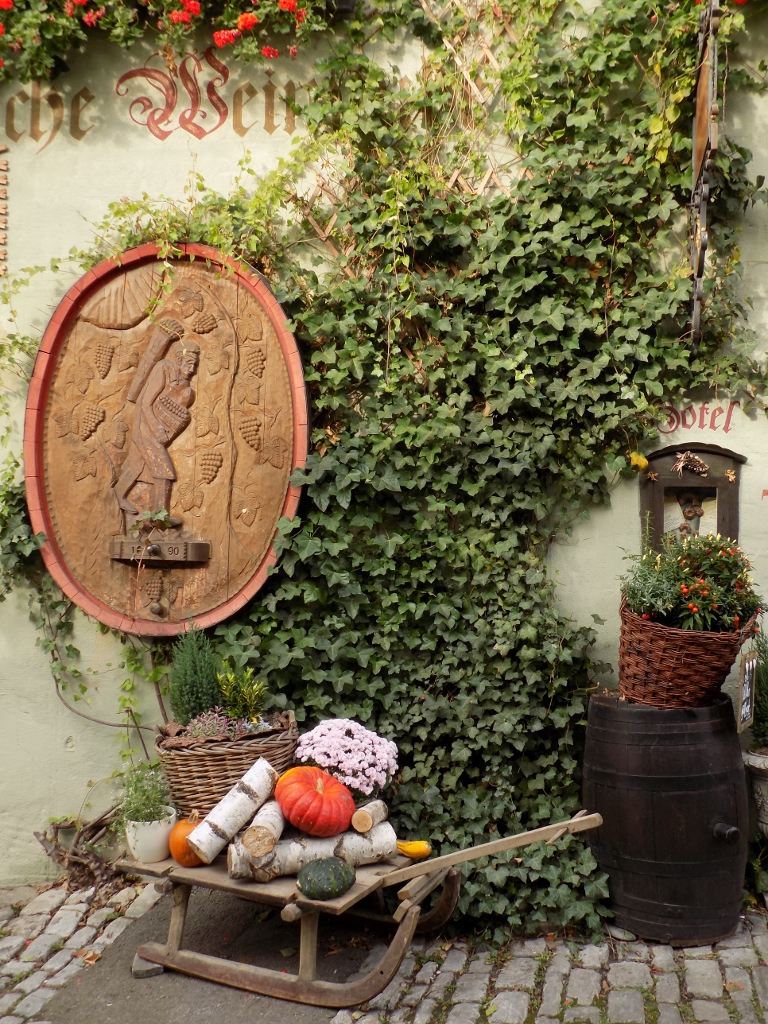 A detail from the streets of Rothenburg
A detail from the streets of Rothenburg